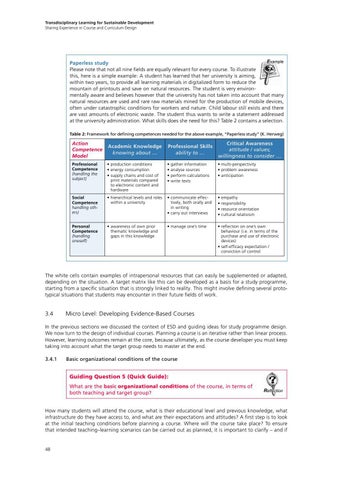Transdisciplinary Learning for Sustainable Development Sharing Experience in Course and Curriculum Design
Paperless study Please note that not all nine fields are equally relevant for every course. To illustrate this, here is a simple example: A student has learned that her university is aiming, within two years, to provide all learning materials in digitalized form to reduce the mountain of printouts and save on natural resources. The student is very environmentally aware and believes however that the university has not taken into account that many natural resources are used and rare raw materials mined for the production of mobile devices, often under catastrophic conditions for workers and nature. Child labour still exists and there are vast amounts of electronic waste. The student thus wants to write a statement addressed at the university administration. What skills does she need for this? Table 2 contains a selection. Table 2: Framework for defining competences needed for the above example, “Paperless study” (K. Herweg)
Action Competence Model
Critical Awareness attitude / values; willingness to consider …
Academic Knowledge knowing about …
Professional Skills ability to …
Professional Competence (handling the subject)
•p roduction conditions • energy consumption • supply chains and cost of print materials compared to electronic content and hardware
• • • •
gather information analyse sources perform calculations write texts
• multi-perspectivity • problem awareness • anticipation
Social Competence handling others)
• hierarchical levels and roles within a university
• communicate effectively, both orally and in writing • carry out interviews
• empathy • responsibility • resource orientation • cultural relativism
Personal Competence (handling oneself)
• a wareness of own prior thematic knowledge and gaps in this knowledge
• manage one’s time
• reflection on one’s own behaviour (i.e. in terms of the purchase and use of electronic devices) • self-efficacy expectation / conviction of control
The white cells contain examples of intrapersonal resources that can easily be supplemented or adapted, depending on the situation. A target matrix like this can be developed as a basis for a study programme, starting from a specific situation that is strongly linked to reality. This might involve defining several prototypical situations that students may encounter in their future fields of work.
3.4
Micro Level: Developing Evidence-Based Courses
In the previous sections we discussed the context of ESD and guiding ideas for study programme design. We now turn to the design of individual courses. Planning a course is an iterative rather than linear process. However, learning outcomes remain at the core, because ultimately, as the course developer you must keep taking into account what the target group needs to master at the end. 3.4.1
Basic organizational conditions of the course
Guiding Question 5 (Quick Guide): What are the basic organizational conditions of the course, in terms of both teaching and target group? How many students will attend the course, what is their educational level and previous knowledge, what infrastructure do they have access to, and what are their expectations and attitudes? A first step is to look at the initial teaching conditions before planning a course. Where will the course take place? To ensure that intended teaching–learning scenarios can be carried out as planned, it is important to clarify – and if
48














